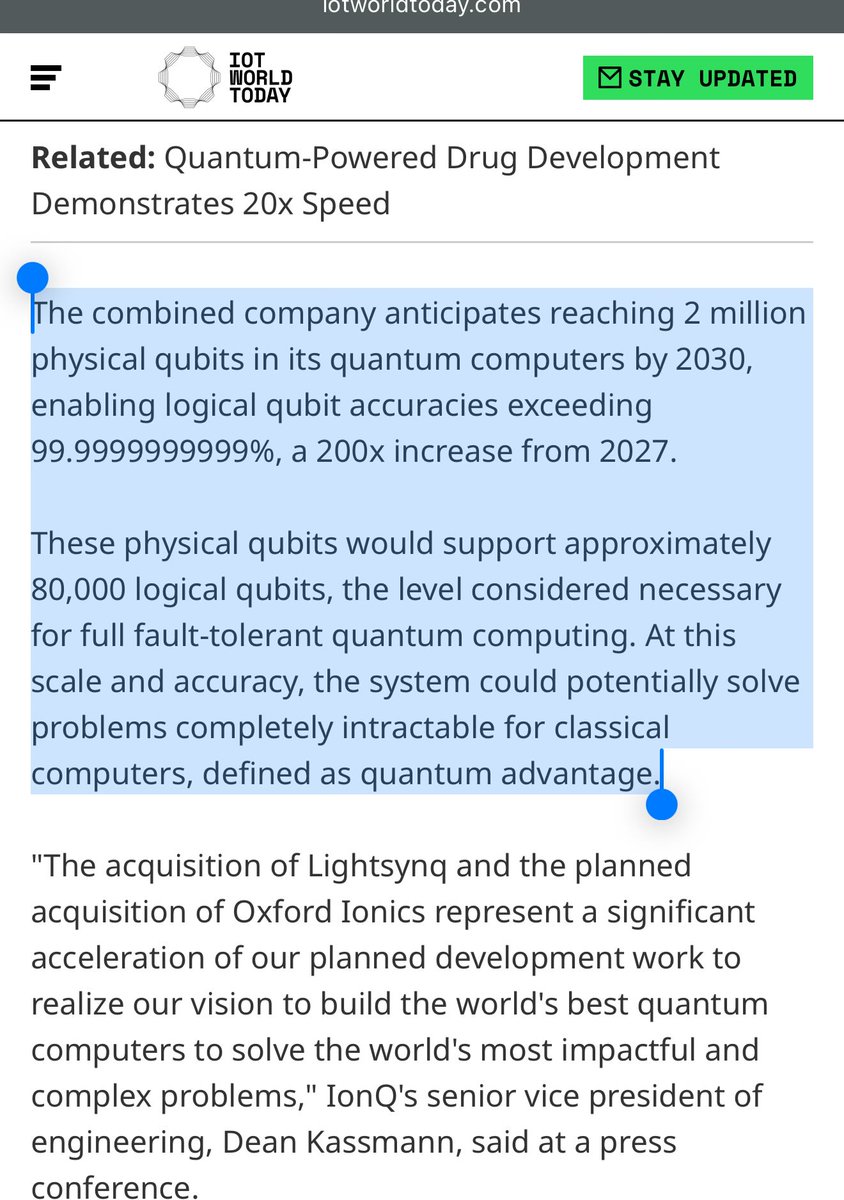[GUEST ACCESS MODE: Data is scrambled or limited to provide examples. Make requests using your API key to unlock full data. Check https://lunarcrush.ai/auth for authentication information.]  J Keynes [@JKeynesAlpha](/creator/twitter/JKeynesAlpha) on x 8891 followers Created: 2025-06-26 13:40:34 UTC $IONQ IonQ promises XXXXXXXXX qubits by 2030, Korea buys XX qubits for 2029? 🤷 Walk me through this like I am five, because the math does not add up once you use grown-up numbers. IonQ just told Wall Street that, after it folds Oxford Ionics into the tent, it will leap from the sub-100-qubit rigs it sells today to XXXXXXXXX physical qubits by 2030, which it says will compress into about XXXXXX logical qubits at XXXXXXXXXXXXX % fidelity. That promise is already eye-popping, but the company also claims a 10,000-qubit milestone by 2027, so the step from XXXXXX to XXXXXXXXX qubits would be a two-hundred-times jump in only three years. Now place that against South Korea’s brand-new “world-class” order. According to @ShawnKwon11 Seoul will pay ₩48.2 billion (≈ $XX million) for a system that only needs “more than XX qubits” with two-qubit fidelity of at least XX %. The contract runs for three years and nine months and does not have to be accepted until January 2029. The machine will be parked beside KISTI’s next NVIDIA-GPU supercomputer so academics can poke at it over the cloud. If X million qubits and full fault tolerance are truly five years away, why is a G-20 government happy to fund hardware that will be outdated before it even boots? Either the glossy slide deck is fantasy or the Korean tender spec is absurdly timid, and neither answer makes IonQ look consistent. The gap widens when you look at error correction. IonQ says those X million physical qubits will fuse into 80, XXX logical qubits that fail only once per trillion operations. South Korea is content with raw qubits that fail roughly once per hundred operations. Bridging that gulf is the entire unsolved engineering stack of error-correcting codes, control electronics, etc. Money tells the same story. The Korean deal will dribble in at about $X million of revenue per year, pocket change next to the ≈ $XXXX billion IonQ has agreed to spend on Oxford Ionics and the cash it will burn trying to scale ion traps from dozens to millions of qubits. Right now the company’s roadmap promises science-fiction scale in five years, while its biggest public customer is thrilled with specifications that look like 2025 old roadmap technology. Until IonQ starts booking contracts that demand hundreds of thousands of qubits on tight delivery schedules, the X million-qubit headline reads more like marketing helium than a credible delivery plan.  XXXXXX engagements  **Related Topics** [wall street](/topic/wall-street) [told](/topic/told) [korea](/topic/korea) [$ionq](/topic/$ionq) [Post Link](https://x.com/JKeynesAlpha/status/1938230909708190146)
[GUEST ACCESS MODE: Data is scrambled or limited to provide examples. Make requests using your API key to unlock full data. Check https://lunarcrush.ai/auth for authentication information.]
 J Keynes @JKeynesAlpha on x 8891 followers
Created: 2025-06-26 13:40:34 UTC
J Keynes @JKeynesAlpha on x 8891 followers
Created: 2025-06-26 13:40:34 UTC
$IONQ IonQ promises XXXXXXXXX qubits by 2030, Korea buys XX qubits for 2029? 🤷
Walk me through this like I am five, because the math does not add up once you use grown-up numbers. IonQ just told Wall Street that, after it folds Oxford Ionics into the tent, it will leap from the sub-100-qubit rigs it sells today to XXXXXXXXX physical qubits by 2030, which it says will compress into about XXXXXX logical qubits at XXXXXXXXXXXXX % fidelity. That promise is already eye-popping, but the company also claims a 10,000-qubit milestone by 2027, so the step from XXXXXX to XXXXXXXXX qubits would be a two-hundred-times jump in only three years.
Now place that against South Korea’s brand-new “world-class” order. According to @ShawnKwon11 Seoul will pay ₩48.2 billion (≈ $XX million) for a system that only needs “more than XX qubits” with two-qubit fidelity of at least XX %. The contract runs for three years and nine months and does not have to be accepted until January 2029. The machine will be parked beside KISTI’s next NVIDIA-GPU supercomputer so academics can poke at it over the cloud.
If X million qubits and full fault tolerance are truly five years away, why is a G-20 government happy to fund hardware that will be outdated before it even boots? Either the glossy slide deck is fantasy or the Korean tender spec is absurdly timid, and neither answer makes IonQ look consistent.
The gap widens when you look at error correction. IonQ says those X million physical qubits will fuse into 80, XXX logical qubits that fail only once per trillion operations. South Korea is content with raw qubits that fail roughly once per hundred operations. Bridging that gulf is the entire unsolved engineering stack of error-correcting codes, control electronics, etc.
Money tells the same story. The Korean deal will dribble in at about $X million of revenue per year, pocket change next to the ≈ $XXXX billion IonQ has agreed to spend on Oxford Ionics and the cash it will burn trying to scale ion traps from dozens to millions of qubits.
Right now the company’s roadmap promises science-fiction scale in five years, while its biggest public customer is thrilled with specifications that look like 2025 old roadmap technology. Until IonQ starts booking contracts that demand hundreds of thousands of qubits on tight delivery schedules, the X million-qubit headline reads more like marketing helium than a credible delivery plan.

XXXXXX engagements
Related Topics wall street told korea $ionq